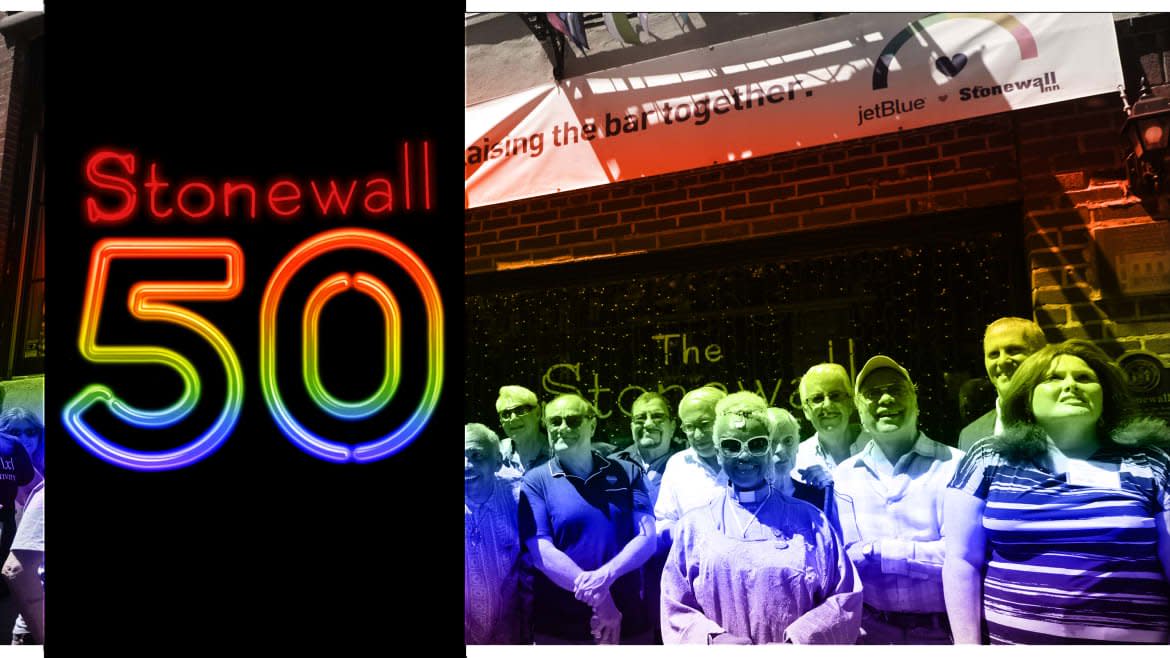March With Joy, Anger, and Power: Why Stonewall 50 and World Pride Is So Important to LGBTQ People

The big day, Sunday June 30, dawns, and New York City is very visibly bursting at the seams with LGBTQ people, their loved ones and allies. They have whistles and—as your ears will know by 6 p.m. today—they know how to use them. There are no more rainbow flags, rainbow sunglasses, and rainbow shirts left in the city. Only very specific meteorological conditions can produce another rainbow.
There will be two Pride marches in New York on Sunday: the Queer Liberation March, setting off at 9.30 am from outside the Stonewall Inn and making its way to Central Park. This march has been set up in protest against the over-corporatization and the police presence at the main Pride march, which sets off at noon from the Flatiron.
This year it is both World Pride and the 50th anniversary of the Stonewall Riots, and an estimated 4 million people in NYC will be out celebrating, shouting, marching, and applauding.
People often ask, what the mood is like at Pride; and sometimes at Pride, even in a positive year of political advancement, that mood can be mixed. There is the sheer joy and elation of seeing such a massive LGBTQ presence; LGBTQ people of every kind, every shape, every color. There is the collective strength, chants, and the sight of brilliant organizations like SAGE, GMHC, the Stonewall Veterans Association, GLSEN, and the Trevor Project.
If you are on the parade, you will not soon forget the scale and euphoria; there is flesh, glitter, astonishing dancing, kisses, slogans, signs, smiling, loud music. Seeing people experience Pride for the first time—either as a participant or as an onlooker—is always a thrill. At Pride, the personal is political; there are four million stories of being there on the streets of New York City today.
If you hate the corporations, the Queer Liberation March is your alternative. Or you can, as so often happens, simply collect their swag they will throw at you and roll your eyes, and cheer the heroes in the LGBTQ community who campaign for change and provide support for those who need it.
Pride can also, quite simply, be an overwhelming day and especially this year—where anger and self-reflection bubble alongside the joy. There is the ongoing roller coaster of LGBTQ life under Trump, and the threats to equality represented by an administration that means LGBTQ people harm. Transgender people find themselves in particular legislative danger—most blatantly revealed in President Trump’s ban on transgender servicepeople.
The courts are being bolstered with judges hostile to us. The struggle is in no way over; it is simply going into another alarming evolution. Both Trump and President Putin claim to have no animus towards LGBTQ people. That is what LGBTQ people are dealing with now, being gaslit by leaders who won't willingly voice homophobia, while legislating homophobia.
Note that this is World Pride, and the plight of those LGBTQ people in countries whose sexuality and gender identity is viciously patrolled and persecuted.
A cornerstone of the mood of the parade should be furious, resistant, a resounding pride in difference and outrage—the absolute mood of Stonewall—and that mood should collectively infuse the politics of many countries where LGBT people still struggle for visibility, equality, and even basic safety.
Pride, this Pride, is one of many moods. There is so much LGBTQ anger and sadness, so much internalized in a typical day and week given the news cycle, that a Pride weekend where one may feel a lot of everything is the most natural kind of Pride weekend. Resistance isn’t always fury; resistance is a statement of belief and resolution, your very own line in the sand of never going back, of carrying on, of finding a sense of community that works for you. That is what Pride can give you today.
All month, I have overseen The Daily Beast’s Stonewall 50 and Pride coverage, which has been a collection of essays and features I hope represent a meaningful slice of LGBTQ feeling of today and back then.
We have looked at what happened at the Stonewall Riots, and celebrated and remembered those who were there; we have asked if too much is invested in them; we have looked at the history since Stonewall (of advancement, hostility, and the devastation of AIDS); we have looked at the law; we have asked what Generation Z makes of this moment; we have looked at America’s other Stonewall-echoing flashpoints; we have asked what Stonewall’s 50-year span to today has meant to lesbians, trans people, people of color, and bisexual people.
And we asked 82 LGBT public figures what Stonewall meant to them, and in their answers they told us stories of coming out, coming to consciousness, feeling angry, empowered, feeling a sense of loss, and a sense of togetherness. These are stories of lives which have been helped to have been made whole by the brave uprising of Stonewall 50 years later.
Today, LGBTQ people reach back and we reach forward. And we do it among friends that we know, don’t know, and who knows how we’ll know by the end of the weekend. And also this year, we feel a different kind of strength because of the very special anniversary it marks.
In 1969—whatever is true and isn’t true about the many stories of the Stonewall Riots—those few nights in 1969 showed the power of the few. They said: no more, they fought back, then they got organized.
Now, thanks to them and their legacy, we can harness the power of the many. Today, do as they did: smile, march, laugh, dance, kiss, hug, fight back, organize, help others, shout—furiously.
Get our top stories in your inbox every day. Sign up now!
Daily Beast Membership: Beast Inside goes deeper on the stories that matter to you. Learn more.

